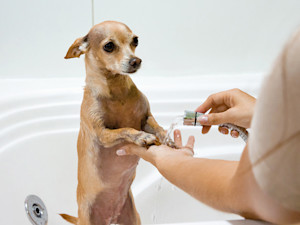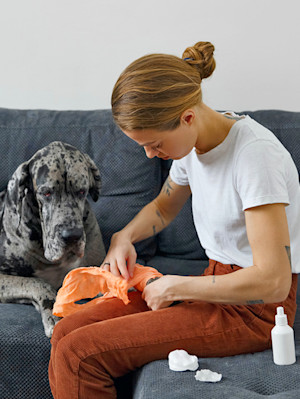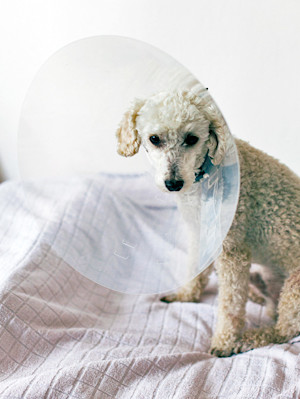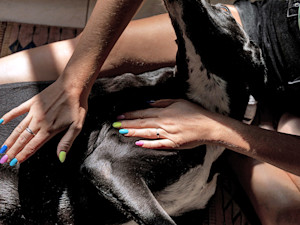Can I Put Sudocrem On My Dog?
In this article:
What is Sudocrem? Benefits of Sudocrem for dogs Risks of Sudocrem for dogs Sudocrem uses How to apply Sudocrem to dogs When to consult a vet Sudocrem for dogs FAQs
Sudocrem’s Antiseptic Healing Cream has been around for decades (nine, to be exact) and can be used on a whole host of (human) skin issues. But can it also be used for dogs? In short, yes; Sudocrem is generally safe to apply to dogs to help alleviate the symptoms of certain skin issues. However, as with most human-first products and foods, it should be used with plenty of caution and some caveats.
Sudocrem can be toxic if ingested by dogs, so the key is to apply it in small amounts. As Sudocrem is a human medication, it’s important to discuss any use with your vet before applying it to your pup’s skin.
Main takeaways
Sudocrem can be a useful addition to a pet first aid kit and may help treat certain skin conditions after consultation with your vet.
Sudocrem is toxic if ingested in large amounts, so always apply a thin layer and ensure your dog does not lick it off.
If your pet’s skin condition worsens or does not improve, consult your vet for further advice and appropriate treatment.
What is Sudocrem?
A stalwart staple of many household first-aid kits, it feels as if Sudocrem has been around forever, but what is it exactly? The brand’s original Antiseptic Healing Creamopens in new tab is an over-the-counter human medication containing several active ingredients, including zinc oxide, benzyl alcohol and lanolin and is designed to be applied to the skin. It’s an antiseptic healing cream that, in humans, is used to treat a variety of skin conditions, including nappy rash, eczema, minor burns, cuts and grazes, and acne.
Benefits of using Sudocrem on your dog
Soothes the skin
Sudocrem has several properties that make it beneficial for treating skin issues in dogs. The cream contains lanolin, an emollient that soothes and softens the skin, making it feel more comfortable for your dog.
Protects against bacteria
The presence of benzyl alcohol gives the cream antiseptic and disinfectant properties, preventing infection and promoting cleaner healing. Sudocrem has a water-repellent base that forms a protective barrier on the skin, shielding it from external irritants like urine or faeces, which can aggravate sensitive areas.
Helps to heal wounds
Sudocrem contains a mild local anaesthetic, which can help alleviate pain and reduce irritation in affected areas, and the presence of zinc oxide helps to prevent fluid loss from the skin, which can be particularly useful in promoting healing and preventing further irritation.
Risks and drawbacks of using Sudocrem on dogs
As much as we’d like to think Sudocrem is a super product, it’s also a human product, which means it hasn’t undergone the same rigorous testing on dogs as veterinary-approved treatments. While it’s generally safe to apply topically, there are some important risks to consider:
Zinc oxide can be toxic if ingested in large quantities. If your dog licks and ingests a significant amount of Sudocrem, it could result in symptoms such as vomiting, loss of appetite and lethargy. It’s essential to apply a thin layer and prevent your dog from licking it by using an Elizabethan collar (or... the cone of shame).
Some dogs may be allergic to one or more of the ingredients, causing mild irritation, redness or rashes.
For these reasons, always check with your vet before using Sudocrem on your dog. If your dog’s skin condition isn’t improving or is getting worse, contact your vet – delaying the appropriate treatment can often worsen the initial problem.
What can Sudocrem be used to treat?
With your vet’s approval, Sudocrem can be used to treat various skin issues, such as:
Urine scald (particularly in dogs with incontinence).
Sore bottoms from diarrhoea (which can cause irritation or abrasions).
Minor cuts and grazes.
Dry skin and rashes.
Red, inflamed areas of skin.
Hot spots (moist, inflamed patches of skin).
Minor burns.
If the condition doesn’t improve within a few days or worsens, it’s important to contact your vet and discuss other treatment options.
When should Sudocrem not be used?
Sudocrem is not suitable for certain types of wounds. In particular, it should not be applied to large, deep or severely infected wounds (eg, those with pus or a foul smell). Additionally, if your dog has had an allergic reaction to Sudocrem in the past, do not use it again.
How to apply Sudocrem to your dog’s skin
Before you reach for that giant pot of Sudocrem, remember to always consult your vet about your pup’s particular ailment. Once you’ve got the green light, you can apply Sudocrem to your dog by following these steps:
Clean the area: use a pet-safe antiseptic, such as Chlorhexidine or saline solution, and gently wash the affected area.
Dry thoroughly: pat the area dry with a clean towel. This is important to ensure the cream adheres properly.
Wear gloves: if your dog’s skin condition is potentially contagious, wear gloves while applying Sudocrem. If you don’t use gloves, make sure your hands are clean and avoid double-dipping into the pot to prevent contamination.
Apply a thin layer: using clean hands, apply a thin, even layer of Sudocrem to the affected area. Gently massage it into the skin using small circular motions to help it absorb.
Avoid sensitive areas: do not apply near the eyes or mouth, as the cream could cause irritation.
Wash your hands: after applying Sudocrem, thoroughly wash your hands to avoid accidentally transferring any cream elsewhere.
Prevent licking: to stop your dog from licking the cream off, you may need to use an Elizabethan collar (cone). This is crucial: Sudocrem can be toxic if ingested by your dog.
Watch for stains: sudocrem can stain fabrics, so make sure to keep your dog in an area where it’s unlikely to stain furniture or clothing until the cream is absorbed.
Sudocrem is usually applied once or twice daily. If the skin condition worsens or doesn’t improve after a few days, contact your vet.
When to consult a vet
Before applying Sudocrem for the first time, it’s important to check with your vet that it is appropriate for your dog’s specific circumstances and current ailment. Here are other situations where you should consult a vet:
If the skin condition is getting worse or not improving within 24–48 hours.
If you or other pets in the household develop similar symptoms.
If your dog develops new symptoms or appears to be in significant painopens in new tab.
If your dog eats a large amount of Sudocrem.
Sudocrem on dogs frequently asked questions
Is Sudocrem safe for dogs?
Yes, Sudocrem can be safely applied to dogs’ skin in small amounts. However, it is crucial to always consult with your vet before using it and prevent your dog from ingesting it. If your pet’s condition worsens or doesn’t improve, seek further veterinary advice.
What human cream can I use on my dog?
It’s generally best to avoid using human creams on your pet unless approved or recommended by your vet. Many human products can cause more irritation than good. However, medical-grade manuka honey, aloe vera, calendula cream and colloidal silver are commonly used in treating skin conditions in pets and are often considered safe. None of these should be ingested, though, as they could still harm your dog.
How do you bathe a dog with irritated skin?
Bathing a dog with irritated skin requires gentle care. Consult your vet before bathing a dog with irritated or broken skin, particularly for the first time after the onset of symptoms. Many shampoos can worsen skin conditions, so it’s better to use a pet-safe antiseptic or sterile saline solution diluted in warm water.
Avoid using human shampoos, as these often contain harmful chemicals. If you need to use shampoo, make sure it is specifically designed for dogs, preferably one recommended by your vet. Rinse thoroughly to avoid further irritation, and after the bath, towel dry your dog or use a hairdryer on the lowest heat setting to help prevent excess moisture from making the condition worse.
Can you put Sudocrem on a dog’s sore bottom?
Yes, Sudocrem can be used to treat sore bottoms caused by diarrhoea or irritation. Ensure the area is well cleaned and dried thoroughly before applying a thin layer of Sudocrem to the affected area. Speak to your vet if symptoms of either the underlying cause (eg, diarrhoea) or irritation get any worse or don’t show signs of improvement.









